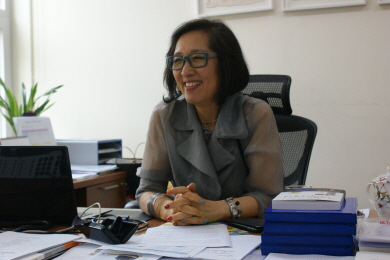
For most people, starting a career after years of housework is daunting. Few would expect to become an expert in the field or work with notable international figures. However, Kim is one who broke such misconception.
After graduating from Ewha, she began studying art history in her 30s. That was when she realized her severe lack of knowledge in contemporary art. Now, Kim is the head of the art museum that is representative of Seoul.
Recently, she has served as the first Korean and the sole Asian selection committee member for the artistic director of the 2017 Kassel Documenta exhibition.
Today, Kim sets the direction for SeMA, leading projects where its employees realize SeMA’s vision of becoming a “post museum.”
“Post museum is a museum for the people,” Kim said. “The goal of SeMA is to become an institution for social network where the relationship between the artwork and the spectator is prioritized over the aesthetic value of the artwork.”
Kim remarked that the SeMA color exhibitions represent the identity of the museum. Composed of three exhibitions named the SeMA blue, gold and green, and the three biennales exhibit artworks of young, mid-career and established artists respectively.
Kim revealed that the objectives for SeMA are to become a glocal museum and one that is loved by citizens.
“SeMA’s goal is to become a world-renowned museum while retaining Korean tradition and heritage,” Kim said. “It should be both global and local. Also, we aim to create a museum that communicates with citizens as well as the world. Ultimately, a museum that is appreciated locally will be acknowledged globally and vice versa.”
Kim is a director of a public art museum, which is usually considered to be conservative compared to private art museums. Yet, she is a pioneer of the alternative art movement in Korea.
In fact, she started her career as an independent curator instead of working for an art museum. She later worked as the director of Ssamzie Space, an alternative exhibition space, for 10 years.
Alternative exhibition space is a place for emerging artists and aims to create futuristic values as well as conquer the drawbacks of the existing system.
“The success at Ssamzie Space has helped me to become the director of Gyeonggi Museum of Modern Art and SeMA,” Kim said. “By working 10 years at Ssamzie Space, I learned that alternative culture can change the world. An art museum can only develop by accepting young people’s ideas. Thus, I try to be interested in their underground, avant-garde art. As the director of SeMA, I work to bring underground art into the mainstream, expanding the boundaries of art.”
Similar to acting as a bridge between different types of art, she served as an anchor between students with different personalities at Ewha.
“In university, I became friends with diverse people and an attentive listener,” Kim explained. “My character has been helpful at work. It is important to retain your identity but you should not enforce your ideas on other people.”
Kim remarked that majoring French in university has helped build her career.
“I was able to acquire knowledge in humanities by studying French literature,” Kim said. “Having a humanities background is important for studying art history since the subject is linked with liberal arts.”
Still, Kim relates that there were obstacles in her career.
“Because I started working after years of being a housewife, many people were prejudiced about my background,” she said. “At first, I was not acknowledged in the art industry. Nevertheless, I studied and worked hard to break their prejudice.”
Kim also gave advice to students at Ewha about ways to succeed in career.
“In order to succeed, it is important to have an insight to predict the future,” she said. “In order to develop that insight, students should focus on the present by absorbing a lot of information and internalizing them.”
Huh Ryun-jung
ryunhuh@ewhain.net

